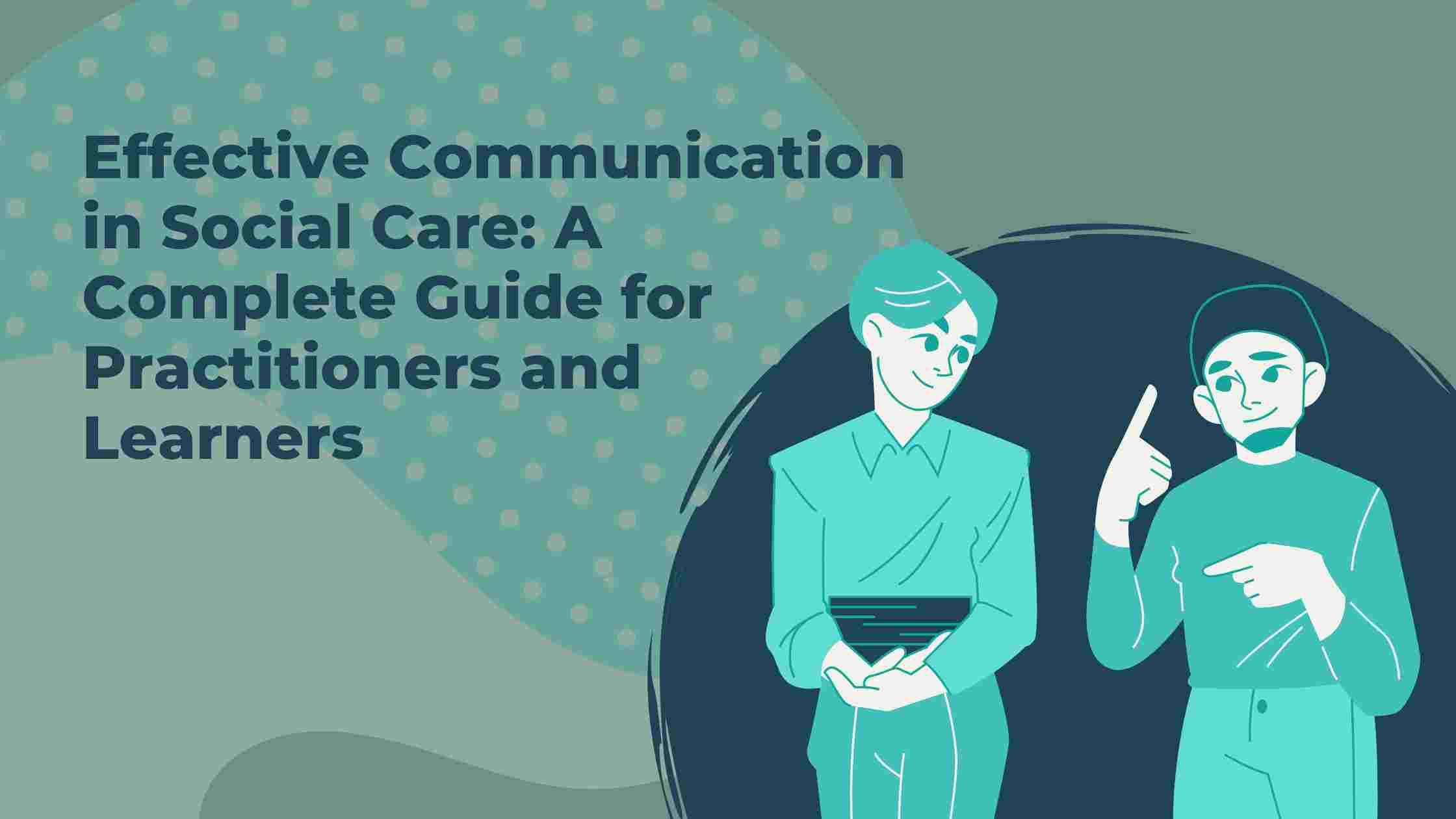Introduction
Communication is one of the most important abilities in the field of health and social care. Delivering person-centered care requires the capacity to communicate ideas properly, comprehend people accurately, and establish deep connections. This thorough manual examines the value, tenets, approaches, difficulties, and strategies for perfection of effective communication in social care.
Gaining proficiency in communication improves results for people receiving care, builds trust, and lowers miscommunications, regardless of your role—student, care assistant, social worker, or service manager.
What is Effective Communication in Social Care?
The process of sharing information, emotions, and understanding amongst people in a way that fosters clarity, empathy, respect, and support is known as effective communication in the social care industry.
This involves:
- Active listening
- Verbal and non-verbal communication
- Written records and documentation
- Cultural and emotional sensitivity
- Use of communication aids when required
Why is Communication Important in Social Care?
Effective communication underpins every aspect of care delivery. It ensures:
- Individual needs and preferences are understood
- Safe, respectful, and coordinated care
- Empowerment and inclusion
- Legal and ethical compliance
Poor communication can lead to:
- Confusion and distress
- Medical errors or safeguarding failures
- Breakdowns in trust
- Inefficient service delivery
Types of Communication Used in Social Care
1. Verbal Communication
Used in conversations, assessments, meetings, and daily care tasks.
- Tone of voice
- Clarity of language
- Open-ended questions
2. Non-Verbal Communication
Includes:
- Facial expressions
- Eye contact
- Body posture
- Gestures
- Touch (where appropriate)
3. Written Communication
Used for:
- Care plans
- Reports
- Incident logs
- Emails and digital messages
4. Visual and Technological Aids
- Picture exchange systems
- Communication boards
- Apps and assistive technology
5. Symbolic and Alternative Communication
- British Sign Language (BSL)
- Makaton
- Braille
- Objects of reference
Key Principles of Effective Communication in Social Care
1. Person-Centredness
Tailoring communication to the individual’s needs, preferences, and values.
2. Clarity and Simplicity
Avoid jargon; use straightforward language that suits the individual’s understanding.
3. Respect and Dignity
Treat every person with equal value and consideration.
4. Empathy and Compassion
Understand and validate the emotions and experiences of others.
5. Confidentiality
Maintain privacy while ensuring vital information is shared responsibly.
6. Cultural Sensitivity
Recognize and adapt to language, beliefs, and communication styles from different cultures.
Barriers to Effective Communication in Social Care
Understanding common obstacles can help practitioners overcome them.
| Barrier | Description | Solution |
| Language differences | Client speaks a different language | Use interpreters, visual aids |
| Hearing impairments | Reduced auditory processing | Use written communication, hearing aids |
| Cognitive disabilities | Dementia, autism, or brain injury | Use clear, simple language; repeat if necessary |
| Emotional distress | Anxiety or trauma affects ability to speak | Use calm tone, offer reassurance |
| Environment | Noisy, busy settings | Choose quiet, private spaces |
| Staff time constraints | Rushed interactions | Prioritize listening, plan time better |
The Role of Active Listening
Active listening is the cornerstone of effective communication. It involves:
- Giving full attention to the speaker
- Nodding or using short verbal cues
- Avoiding interruptions
- Paraphrasing or summarizing for understanding
Strategies for Improving Communication in Social Care
1. Training and Continuous Development
Staff should receive training in:
- Communication theory
- Equality and diversity
- Working with disabilities or mental health needs
2. Use of Communication Care Plans
Each individual should have a personalised communication plan that includes:
- Preferred method of communication
- Cultural or religious considerations
- Use of aids or support tools
3. Multidisciplinary Communication
Care often involves multiple professionals. Strategies include:
- Regular team meetings
- Clear written documentation
- Shared care records
4. Family and Advocate Involvement
Family members or advocates can support communication for:
- Consent and decision-making
- Health history or emotional needs
5. Technology and Innovation
Use tools such as:
- Voice recognition software
- Video calls
- Accessible mobile apps
Legal and Ethical Considerations
Effective communication is not just best practice—it’s a legal obligation:
- The Care Act 2014 promotes well-being through understanding.
- Mental Capacity Act 2005 requires clear communication for decision-making.
- Equality Act 2010 mandates adjustments for people with disabilities.
Case Studies in Communication Excellence
Case 1: Supporting an Adult with Autism
Staff used Makaton and visual routines to communicate with a non-verbal adult, reducing distress and building rapport.
Case 2: Dementia Care in a Care Home
Use of memory books and familiar music improved communication and engagement with residents.
Case 3: Multilingual Support in Community Care
A support worker used translated documents and a bilingual colleague to assist an elderly Polish client in navigating social services.
Monitoring and Evaluating Communication Effectiveness
Regularly review communication practices by:
- Seeking feedback from service users and families
- Holding supervision and debriefs with staff
- Auditing care documentation
- Reflecting on incidents where communication broke down
Building a Communication-Positive Culture
Care organisations must:
- Model respectful communication from leadership
- Celebrate inclusive practice
- Embed communication in staff inductions and policy
Tools and Resources for Enhancing Communication
- SCIE (Social Care Institute for Excellence) guides
- NICE guidelines on service user involvement
- Communication Passport Templates
- BSL and Makaton training courses
- Accessible Information Standard (AIS) resources
Conclusion
Building relationships, attending to individual needs, and providing high-quality, person-centered care all depend on effective communication in social care sector. Every encounter influences the experiences of individuals receiving care, from actively listening to recognizing cultural clues and overcoming communication difficulties.
Social workers may make sure their communication methods are inclusive, courteous, and powerful by emphasizing training, utilizing the appropriate resources, engaging families, and making a commitment to ongoing reflection.
Remember that communication is a commitment to humanity, not just a skill, whether you’re just starting out in social care or managing a staff.
Read More: What is Communication in Health and Social Care?







